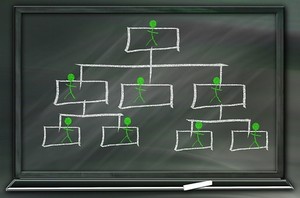Products: positioning and benefits
First of all, the customer's needs are set and compared to what benefits their own products can bring him.
Then the target group analysis and the competitive situation are examined.
Then you get a first impression of your own product positioning on the market. As these changes constantly due to external influences, they must be adjusted regularly. If the market position has become worse, a repositioning of the product to recover the original market position must be made.
Evaluations of complaints are a good source of information for the new positioning. Even a well-functioning own complaint management is a good early warning system for possible sales problems.
Audience Segmentation
If the product analysis does not yield a result that could account for a decline in sales, then the analysis area needs to be expanded. Then you have to take a closer look at the customer page.
Therefore, the next step is to review the current audience segmentation. Because these too can change over time. Criteria may need to be changed. Potential buyers may have become younger or older, the product may have become a mass product from the niche product, etc.
If the target group has changed, information about the new target group has to be obtained. For the target group analysis, the sales department must be included as it usually has the best knowledge about the customers, Also, other information from trade journals and industry associations are easy to get. Of course, market research can also be done.
marketing concept
If the analyzes have led to changes in products or target groups, the previously pursued sales concept must be examined. Because changes may require other forms of distribution. Indirect distribution may be more useful than direct marketing or Internet marketing must be included as a supplement.
However, changes in product positioning or among the target groups usually do not make the previous forms of distribution fundamentally unfit; but an optimal exhaustion may not be possible anymore. An electronics product requiring explanation is presumably still marketable for a longer time after the market launch via the specialized trade, but presumably in the meantime, additional sales channels have been added with the online sales or the mail order business, which must be served if the reachability of the target group is on one comparable level.
sales organization
The sales form and sales organization must be suitable, otherwise efficient sales work can not be carried out. Among other things, it has to be examined whether decentralized sales or central sales are the better option.
If external sales partners are used, sales support and the creation of a training department that qualifies the employees locally may be required. Existing stores may require support in store decoration or promotion.
Depending on the organization, the management style must also be adapted. It can range from targets with consistent control of implementation to partnership-based leadership and high levels of transparency. The management tools for a sales organization need to be carefully selected.
In addition, clear objectives and the ongoing review of progress are essential. Since sales often take place outside the company, reviewing performance is only possible based on the results achieved. At the same time, sales processes are often tedious. This makes leadership in sales mostly demanding and requires a high degree of experience.
sales process
If previous analyzes on product, target groups and distribution form have not produced any negative influences, the analysis of the actual sales process can be informative. If this results in a need for adjustment, the sales process must be adapted in any case
customer acquisition
This includes all tasks such as identification of new customer potentials, the initial offer, the offer preparation and the negotiation until the conclusion of an order. In addition, the administrative tasks are to be taken into account (order entry and processing, shipping, invoicing, maintenance of customer databases or CRM systems, etc.).
For business models with low margins and high volumes, the sales process should be standardized and automated as much as possible. Implementation in an electronic workflow is recommended here.
For complex sales processes, a more flexible handling with process and process descriptions is a better form of implementation.
Especially in the business customer segment, the process of acquiring new customers is particularly important. Because here errors usually mean the loss of high sales potential. The more complex the product to be marketed, the more preliminary work is required. Since the sales cycle often takes many months in the business and large customer area, a provider can not afford too many mistakes here.
Potential analysis of employees
Only after all the above-mentioned analyzes comes the (often and wrongly, already used first) employee potential analysis. This determines the extent to which individual employees meet the requirements arising from the sales process.
In most cases, there is no complete coverage of requirements and potential, so optimization decisions have to be made. For example, the "consultant type" is less suitable in the distribution of consumer goods, just as the good "first contact" is not good in the KAM business.
If the result of the potential analysis deviates too far from the requirements profile, even after training measures, then there is nothing left but to separate from the employee.
Potential analyzes can be carried out in the form of assessments in a group or in the form of individual interviews. Sales assistants can also provide important insights as an element of the potential analysis.
The sales executives must also be involved here. Because of the high demands, leadership and communication skills have to be examined and improved at the management level in addition to the technical qualifications. Regular training in the field of management tools should be self-evident.
sales training
In the case of changes in the sales process, it makes sense to adjust the entire sales team to the changes through training and to practice new approaches. Training can also promote the teambuilding process. As many sales people are traveling frequently, this can have a positive effect on internal cooperation.
The supply of sales training is extensive and covers the various facets of sales work. There are standard programs and training programs specially tailored to the requirements of the company. Here it is necessary to decide on a case-by-case basis which type of training is most appropriate.
Sales accompaniment / -coachings
Individual sales support can also be used as a qualification measure. Coaching can be used to solve individual problems for individual sales representatives, such as before an important customer appointment or when dealing with problem situations.
Both instruments are suitable for supplementing and consolidating other qualification measures.
Regularly brings the most
Since the market situations are typically subject to an increasing dynamic, it makes sense to regularly check the respective requirements. Both the product positioning and the target groups can change quickly. An early observation of the developments and an adjustment in the sales process help to take advantage of the market opportunities as efficiently as possible. This creates the necessary prerequisite of the sales side in order to achieve competitive advantages.
Of course, this does not replace the timely development of the product range - even the best sales can be difficult to survive on the market with a non-competitive item.
Conclusion: systematic and careful
The sales analysis is no substitute for regular sales controlling, but is used when the key figures from sales controlling have a tendency to deteriorate.
The effort involved in carrying out the sales analysis is limited and systematic. However, one should always proceed objectively, since incomplete analyzes can not lead to optimal implementation.



